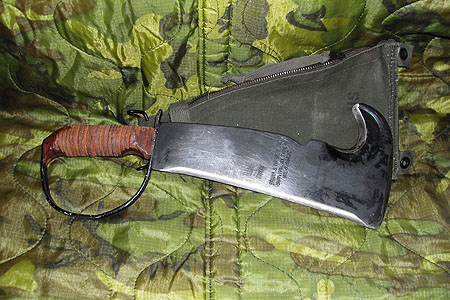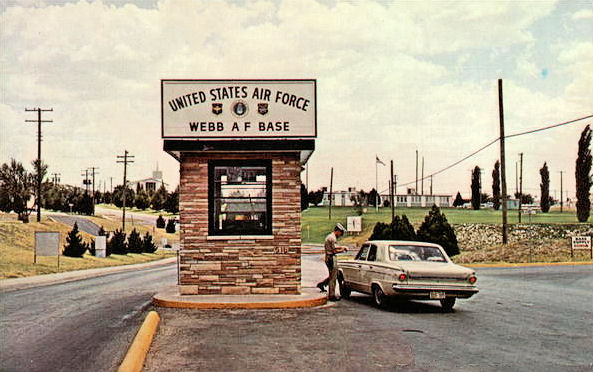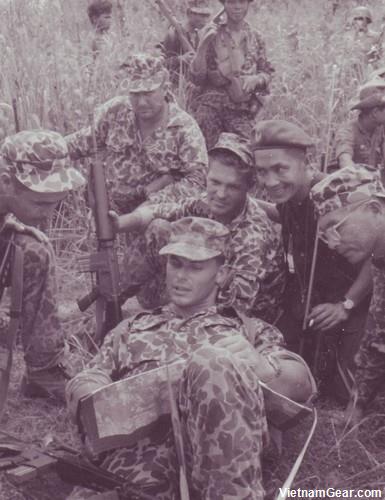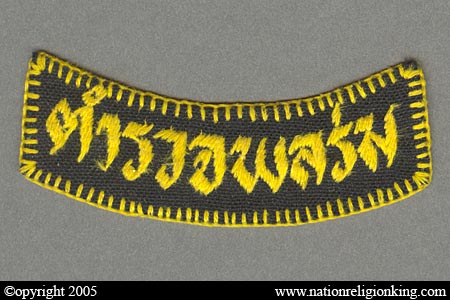Odds and Ends
I thought it was about time to add some stuff I missed earlier in my posts. Someone sent me an email and asked me what we carried in the field. That's a good question because what my team carried on a hump was different in many respects from what the SOG teams carried. Where the SF SOG guys would carry up to 90 pounds of gear, we carried 60 or 70 at most. Thais were smaller people so they had to carry smaller loads.
 |
| WWII BAR Cartridge belt and suspenders. |
My Thais carried AK-47s, smoke grenades, M-26 fragmentation grenades, and anywhere from 200 to 600 rounds of ammo each, depending on the length of the mission and where we were going. Akkrat told me many times that they didn't need a lot of ammo because they could always pick it up off dead enemy soldiers. The Thais carried some rice and dried meat, usually enough to get them by for three to five days. They carried one or two canteens of water and some water purification tablets. One of them carried my PRC-10 or 15 radio. Another carried my GRC-109 HF radio and antenna system. They did not carry sleeping bags, hammocks, or other bedding stuff. They also had, but did not carry very often, a poncho. None wore metal helmets. They, more often than not, dressed in NVA or Pathet Lao uniforms, because at a distance, they couldn't be identified as Thais. They wore locally manufactured sandals and not combat boots. The tracks they left were just like the ones the Pathet Lao would have left. One of their mainstays were their knives and each one had two. One was usually a stiletto of some kind and the other a locally manufactured very sharp knife heavy enough to cut through most anything. They also had machetes.
Now for the stuff I carried. First off was my Swedish SK or my FN-FAL Rifle. I also occasionally carried an AK-47 but not normally. I frankly didn't like it's feel, its accuracy, or its lack of long range impact. I usually managed to carry 500 rounds of ammo for the SK, less for the larger FAL. I wore a WWII and Korean War vintage BAR belt and suspenders. The ammo pouches were really good for carrying ammo and other items. I carried two canteens of water and water purification tablets. I carried the same rations the Thais carried, but occasionally I would sneak in a can of fruit from some C rations. I carried a compass around my neck and only a portion of the map I was given for the mission. All that was necessary was the actual area we were going to operate in. I carried anywhere from four to eight M-26 frags plus at least one white phosphorous grenade. Two smoke canisters. A UC-10 emergency radio and an extra battery was carried in my pack. I did wear high top German made jump boots because I could tuck my pants legs into the tops of them to discourage the leeches from crawling up my leg. It rarely made any difference because the leeches seemed to always find a way to attach themselves to you. I also had some kind of military insect repellent that you could spray the leeches with and make them fall off. I learned early on that you didn't pull a leech off once it attached itself to you because you would bleed for an hour or more after doing it. Once it attached itself, just let it feed and once it has it's meal, it will fall off on its own with a lot less blood loss. I carried a camo towel that I put around my neck and tucked into my shirt for the same purpose; to keep the leeches off. Believe me, no matter what you did, you were going to get leeches on you, especially during the rainy season. I also used friction tape to close my cuffs on my sleeves that helped to keep leeches off your arms and upper torso. It would have been great to have had some velco attachment tape but it wasn't invented at this time.
I carried a small flashlight and extra batteries. I had a Beretta Model M1951 9MM automatic pistol and holster with six clips. Either, I, or Akkrat, would sometimes carry a 22 caliber pistol with silencer for taking out guards and finishing off wounded enemy soldiers. I carried a tube of waterproof matches, but I never lit a fire the whole time I was in and out of Laos...at least not on a hump. I wore German military fatigues with no patches or identification at all. Sometimes a bush jacket. I had a set of green leather work gloves. Sometimes I wore a bush hat, but mostly an old Marine Corps cover (it's a hat, but the Corps doesn't like it called that) . On occasion, when Bradley thought it would appropriate, I wore a PL uniform. . After all, I was tanned and only five foot seven inches tall. Fit in real well with the Thais. There was one thing I learned from the SF guys. They told me not to wear socks or underwear. We stayed wet all the time and because your underwear and socks would never dry out, you ended up with some kind of jungle rot that there was no cure for. I learned that lesson a little late. I still have a foot fungus that no doctor has been able to get rid of. It's controllable, but if you forget to treat it every month, it comes back with a vengeance. A Navy corpsman first aid bag was tied to the pack. I carried a sweater because at the higher altitudes we operated in, it could get down right cold at night, especially after a rain. You wouldn't think that would be the case in SE Asia, but it was. I carried pen flairs and 25 feet of green parachute cord. I also had my trusty K-Bar knife and a really sharp bayonet from an M-1 Carbine. While the Thais carried machetes, I carried pilot's survival tool which I had been given by an Air America pilot. Turns out, it was a very early model of the Frank and Warren Survival Axe. It was really good at cutting through razor or elephant grass and sticky vines. A picture of it is below. It is not the same one I had but very close in appearance.
 |
| Frank and Warren Survival Axe. |
|
|
|
|
|
|
|
Something I didn't have originally, that the SF guys did, was Claymore mines. At some point, Lt. Peterson gave me a dozen with some detonators and some 5, 10 and 30 second fuses and he had one of his guys show us how to use them. They were devastating on enemy troops. If the enemy was in pursuit of you, this was one really good option to slow them down.
 |
| Claymore Mine |
Everything we carried had to be sound proofed. You taped ever thing that could clank or clink against anything else, We threw away the cup in the bottom of the canteen cover because the canteen rubbing against it would make noise that could be heard at quite some distance. We removed the canteen lid and cut the chain to eliminate another noise factor. Anything that would reflect light was covered with tape. I wore my watch upside down to prevent the radium numbers and hands from showing in the dark. I carried my K-Bar knife taped to my suspenders upside down. I did not carry a poncho or rain gear. I mentioned the Thais didn't carry any either and there was a reason for that. Rain, falling on a poncho makes a very audible noise in the jungle. It's a different sound that any tracker would know wasn't natural. It was a huge risk to wear one or to cover yourself with one when it was raining and if it wasn't raining you didn't need it anyway.
There were four priorities on a hump: Weapons, ammunition, water and radios. You could go with out food but to run out of ammo or have a radio fail was truly a bad thing. Ammo and radios gave you a chance of surviving enemy encounters. You surrendered the creature comforts for more ammo, grenades and radio batteries in every case.
As to the SF guys, they carried a lot of ammo, grenades, claymore mines, C-4, radios, batteries, and their weapons. They went light on creature comforts as well. They did carry C and K rations. I never saw any MRE's so I don't know if they existed that early in the war, but they could have had them. Sometimes they had a M-79 grenade launcher with ten or twelve rounds of ammunition. They wore military uniforms but no rank or other identifying patches were on them. They also packed a sweater or jacket for the cool temperatures at altitude in the mountains of Laos. One SF guy on a team I worked with twice, carried a sawed off 12 gauge pump shotgun. The SF guys probably had stuff I never saw and was never intended to see. They all had a side arm of some kind, mostly Colt 1911 45 caliber automatics. They also carried K-Bar knives. So, that is how we were equipped. I am sure I have missed something, but its been a long time since I had to carry that stuff into the field. If I think of anything, I will add it later in an edit.
Another Point
There has been some controversy over whether or not I was a combat controller. Some CCT's have said that since I didn't go through the Hurlburt pipeline, was not assigned a CCT MOS, or did the more conventional things that other CCT's did, that I was not one of them. Because I operated in a war that didn't exist, the records were scrubbed and that was what I was told would be the case. That was reiterated in my first briefing with Col. Bradley. These CCT;s attitude is that I was an air traffic controller working in a combat setting. Others said that I was a tactical air/ground controller, more or less an SF guy or a Army Pathfinder, but in the U.S.Air Force. One said that I was just an Air Force SOG Team member. On the other hand, some CCT's have said that they had heard of our operations, but didn't know who was doing them or what unit they were with. To put the record straight as best I can, I was recruited to be a combat controller. Because of the nature of where I was intended to be posted, in a war that didn't exist, Bailey and I were trained differently so that in effect we didn't exist.. There were two others being trained as well, but they came somewhat after Baily and me so I am not sure who they were or exactly where they went. I was trained by, whom I was told at the time, were older seasoned combat controllers. I knew them by their call signs and the word sergeant .Maybe they weren't. They could have been CIA or Army Special Forces personnel for all I know. Hell, I was eighteen years old when I started training for Laos and probably would have believed anything they said. We were not trained at Hurlburt but rather at Webb AFB in Texas where they had a number of T-28's and some Laotian and Thai pilots who were being trained to fly them there. That was not by accident that we were receiving our training at Webb. I would be controlling these same pilots in Laos a year or so later. The Laotians and Thais could speak passable English, but there were times when some language issues existed. We tried to work those out in the training. The same thing with Ft. Bragg. We did most of our weapons, escape and evasion, and jump training with Special Forces Teams, especially the guys who would eventually make up some of the SOG teams. They would be the guys who I would work with 90 percent of the time in Laos. Since we trained some Hmong soldiers to be FAGs (Forward Air Guides), I suppose we could have been that as well. If I wasn't a combat controller, I have no idea as to what I should be called. Maybe the title tactical air/ground controller is more suited to what I actually did. But, it doesn't bother me either way. I did what I did thinking I was a combat controller. If I wasn't, then, so be it. Whatever you called what I did, it was pretty darn dangerous.
 |
Main Gate Webb AFB About 1962 or So.
|
I do know that later on, the SF guys actually called in their own air strikes and carried out their extractions with American Armed Forces personnel rather than how we had to do it using Air America. I did a little research and they had what they called Covey Riders who rode with the FAC's and directed aircraft to targets. They also were able to keep FAC's (Forward Air Controllers) orbiting overhead directing air strikes against enemy positions for long periods of time. We had no so availability. Just the Lao Air Force of a few planes and Air America's helicopters and fixed wing STOL aircraft. I can only remember one time that I was able to call in F-100's on a target and the AAR (after action report) had to state that they dropped their bombs by accident not knowing exactly where they were. I believe the F-100's were part of the 524th Fighter Wing out of Udorn or Tahkli. Not real sure about that, but they were in the area during that time period. And their bombs saved a SF SOG team for extermination.
AAR's or After Action Reports
After each operation both the SF 1-0 and I had to fill out what was called an AAR. This "after action report" would be reviewed by the CIA and MACV in Saigon. Since I did not go on many complete missions, but was responsible for the LS, I never knew exactly what the SF 1-0 would put in his report. My AAR would detail out what my team's part of the mission encountered and accomplished. You had to note on a map where you encountered and/or engaged enemy troops. I had to indicate on the map any kind of AA or AAA fire we saw our aircraft encounter. You had to note who was injured, wounded, or killed. You had to make as accurate count as possible of enemy KIAs or those wounded that may have gotten back to their own people. It was a the responsibility of the PARU, if they had time, to get as much information off the enemy bodies as they could. If it was NVA troops, they tore or cut off any unit chevrons so we could develop intel on their units. I had to review how the Air America pilots handled their ends of the mission and also how the PARU responded in combat situations. I always had to make suggestions on how we could improve what we were doing. I always said we needed more air power over the LS when we were making insertions and extractions. I also always added that we needed heavy lift helicopters besides the H-34's and Bell 204's. We never got any of the heavy lift stuff, but I still asked for it time and time again.
After the AAR was filed, it was not uncommon to have someone come get you and take you to some building somewhere in Vientiane (it was never the same building or even on the same street) and you would have to answer questions for several hours about the mission. I don't know who those folks were, but they were in suits and ties, not military uniforms. But that would not have been all that unusual in Laos. They wanted to make sure that what you put on the AAR jived with what you actually saw or encountered in the field. It was like taking a test in high school, but all the questions had to be answered "yes" or "no." Something like this: "Your AAR says that your team took fire from 12.7 AA weapons. Yes or no? On your AAR you state that you did not see any indication of 37 MM AA weapons, yes or no?" And that is how it went for one, two, or even four hours. I hope that gives you an indication of what an AAR is and what it is supposed to tell the higher ups.








